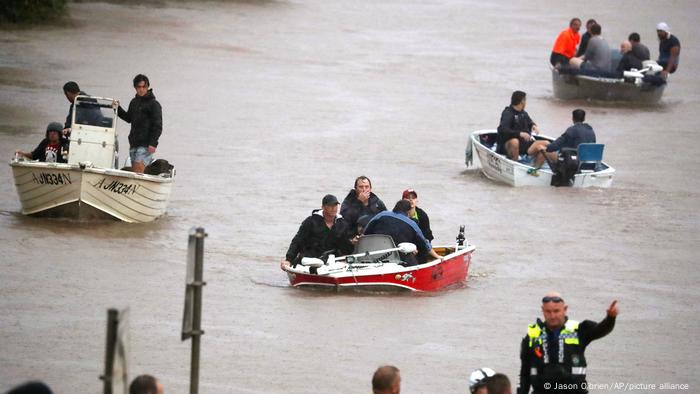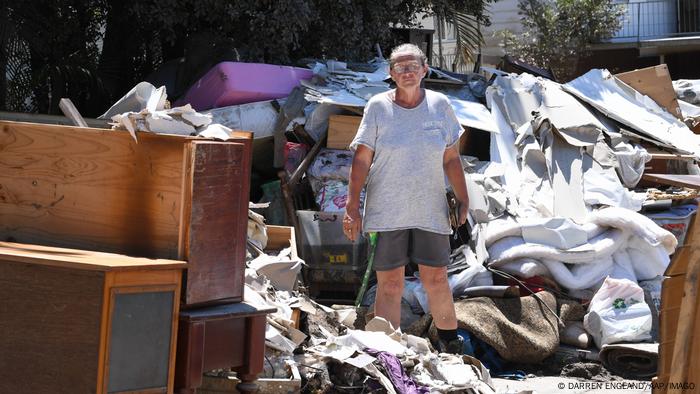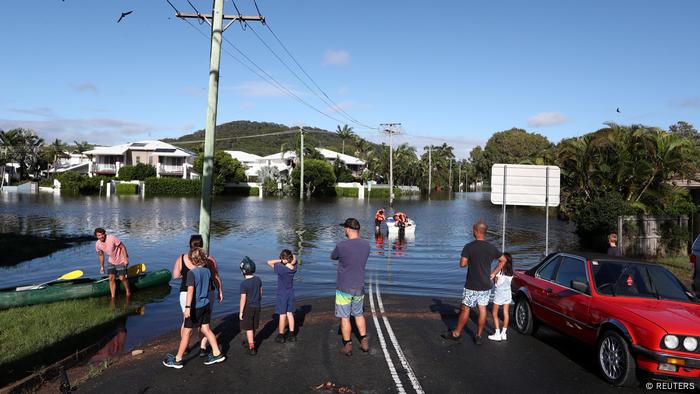Author: AFP| Update: 09.03.2022

A woman kayaks with her dog around her flooded neighbourhood in the Windsor suburb of Sydney / © AFP
Scores of protesters in a flood-wrecked city in eastern Australia vented their fury Wednesday as Prime Minister Scott Morrison visited the heart of the disaster zone.
Demonstrators demanded more help and stronger climate action as Morrison toured Lismore, which endured some of the worst flooding in a near two-week deluge along the east coast that has killed at least 21 people.
"We need help!" protesters chanted as Morrison visited the city.
Many held placards with messages blaming the climate crisis including: "Coal and gas did this" and "This is what climate change looks like."
After the second major floods in a year, chunks of rubble and discarded, water-damaged furniture were piled high along the city's streets.
Many people had to clamber onto their corrugated metal roofs to escape the fast-rising water last week as floods peaked in the city in northern New South Wales.

A used car showroom is seen inundated by floodwaters from the Hawkesbury River in the Windsor suburb of Sydney / © AFP
Some waited for hours to be rescued by locally improvised boat patrols, emergency services vessels or army helicopters as the waters surged around them.
Floodwaters across much of the east coast retreated as rainfall eased Wednesday, but major flood warnings were still in force in some areas including at the Hawkesbury River west of Sydney.
- 'Hard to live in' -
Evacuation orders affecting about 40,000 people in New South Wales were in force in the morning. More than 90,000 people had been allowed to return to their homes.
The death toll from the east coast deluge rose to 21 as police discovered the body of a 50-year-old delivery truck driver in floodwaters in Sydney's west.
Facing pointed questions at a news conference in the city, Morrison defended his government's climate record by stressing its commitment to achieving net zero greenhouse gas emissions by 2050.
"We are dealing with a different climate to the one we were dealing with before. I think that's just an obvious fact," Morrison said. "And Australia is getting hard to live in because of these disasters."
Morrison, who faces an election by the end of May, has underscored his support for coal-fired power stations to provide cheap electricity throughout their lifespans.

Residents steer boats around flooded houses next to the old Windsor Bridge along the overflowing Hawkesbury River near Sydney / © AFP
Even as the floodwaters retreat, the scars on the landscape are widespread.
In Narrabeen, on Sydney's northern beaches, the rains caused landslides that cleaved chunks out of the hillside along residential streets.
Cleaning crews tried to clear away the mud and fallen trees on Wednesday.
- 'Like a bomb' -
"We've never seen it like this before and we have been here 25 years," resident Stephanie Brown said, walking along a muddy road with the family dog.
Her husband, Craig Brown, said a waterfall behind their house had been transformed into a torrent on Tuesday.

A lamp post is seen submerged in the floodwaters / © AFP
"The water that was coming down the side of the house was so strong that I had to hold on to a tree... it was bad," he told AFP.
Mid-morning, the cliff behind his neighbours' house gave way, crashing into the backyard.
"We just heard this massive noise, it was like a bomb going off," Brown said, estimating that 20-30 tonnes of soil, trees and rock had collapsed.
In Vineyard, in Sydney's west, floodwaters swirled near the roof of Paul Dimech's house after a nearby creek transformed into a lake.
"Usually all the neighbours have horses in the paddocks, and now it is just an ocean," he told AFP.
In response to the crisis, the prime minister said people in the hardest-hit areas of northern New South Wales would receive triple the normal disaster payments.
The government is already providing Aus$1,000 ($US730) for adults and Aus$400 for each child affected by the floods.
This was in addition to other measures including Aus$1 billion for grants being provided jointly by the federal government and the states of New South Wales and Queensland, he said.
Morrison, who has just emerged from a week's isolation after contracting Covid-19, said he planned to ask Australia's governor-general to declare a national emergency on Friday, a measure designed to cut red tape in response to crises.
Australia has been at the sharp end of climate change, with droughts, deadly bushfires, bleaching events on the Great Barrier Reef and floods becoming more common and intense as global weather patterns change.
Australia is set to declare a state of national emergency after floods on the country's east coast claimed 22 lives. The new status means flood victims can receive aid quicker.

People had to use boats and flotillas in the town of Lismore last week
Australian Prime Minister Scott Morrison said he would recommend a national emergency be declared after recent floods across large parts of the east coast took 22 lives. Morrison announced the news during a visit to Lismore, New South Wales, where flooding killed four people last week.
“I intend to recommend to the Governor-General to make a National Emergency Declaration covering this severe weather and flooding event across New South Wales and Queensland to ensure all our emergency powers are available and that we cut through any red tape we might face in delivering services and support on the ground," Morrison said in a statement.
What does the state of emergency change?
The declaration was made possible by a new law passed in late 2020 following the devastating Australian bushfires in the previous Southern Hemisphere summer. Some of the flooded communities in the current emergency were battling wildfires two years ago.
The new status means flood victims can bypass providing identification documents to receive support payments. Under some circumstances, the federal government will also be allowed to act independently in areas where state governments hadn’t asked for assistance.
Natural disasters making life harder in Australia
While touring the worst-hit areas of New South Wales, Morrison said on Wednesday, "Australia is becoming a harder country to live in because of these natural disasters."
Floodwaters reached their peak in Queensland’s capital, Brisbane, Australia's third-most populous city, on February 28 after it was inundated by 80% of its usual annual rainfall in the previous three days.
More than 20,000 homes and businesses had been flooded in southeast Queensland alone and 13 people died.

Flood victim Lauraine Ormondpictured outside her house in the suburbs of Goodna, Queensland
Parts of New South Wales' capital, Sydney, Australia’s most populous city, were flooded after receiving almost 75% of its average annual rainfall since January 1, enduring the wettest start to a year ever recorded. Some communities witnessed the highest floods ever recorded in their locations.
Morrison called the flooding "a major catastrophe ... of national proportions."
In the past week, the government has paid out around AU$385 million (€253 million, $281 million) to flood victims nationally with plans to increase aid in Lismore, one of the hardest-hit towns, to provide food and shelter and other support services.
Frustrated residents
But many flood victims are angry that rescue by authorities didn't come earlier and relief efforts were not enough. If it hadn’t been for community members, "we would have been seeing a death toll in the hundreds of people,'' emergency management spokesperson Murray Watt told Australian Broadcasting Corp.
"While people are grateful for the assistance they've had from the army, there's just nowhere near enough of it," Watt added.
Although rainfall has now calmed, 40,000 people around New South Wales had been ordered to evacuate their homes, including dozens in Sydney.
On Wednesday, New South Wales' death toll climbed to nine as police found the body of a 50-year-old truck driver in floodwater in Sydney's outskirts.

In Cabarita, New South Wales, the floods blocked roads
The local Northern Beaches Mayor Michael Regan said some areas of Sydney had been hit with sudden flash floods and multiple landslips on Tuesday, with debris still blocking many roads on Wednesday.
"Yesterday was bizarre. It was intense. It was biblical,'' Regan told Nine Network television.
'The water is rising, no more compromising'
Morrison, who is lagging in polls ahead of an election before May, kept media away from his meetings with flood victims, which he said was to protect their privacy.
Meanwhile, television footage showed some people gathered in front of an emergency operations center Morrison visited, yelling, "The water is rising, no more compromising" and "fossil fuel floods."
Late last year, the prime minister's conservative government adopted a net-zero carbon emissions target by 2050, but climate activists are demanding more aggressive action.
fh/sms AFP, Reuters
Flood warnings stretched across Australia's east coast on Tuesday and tens of thousands of Sydney residents fled their homes overnight as torrential rains again pummelled the country's largest city, causing flash floods.

A man and a woman were found dead on Tuesday near an abandoned car in a stormwater canal in western Sydney, authorities said, while Queensland police confirmed the death of a man missing in floods since Feb. 27, taking the death tally to 20 since the deluge began. Most people were found dead either in flooded homes or in cars attempting to cross flooded roads.
Bureau of Meteorology forecaster Dean Narramore said minor to major flooding was occurring from the Queensland to Victoria border, a distance of more than 1,555 kilometres (966 miles).
"A tough 24 hours or even 48 hours ahead," Narramore said during a media briefing on Tuesday as he forecast up to 120 mm (5 inches) of rains across Sydney over the next 24 hours, with the storm expected to clear by late Wednesday.
Heavy rains lashed Sydney overnight with some suburbs receiving up to 200 mm since Monday morning, exceeding March's mean rainfall of around 140 mm, triggering flash flooding and snap evacuation orders in the southwest of the city.

Television footage showed flooded roads and homes and stranded cars, as well as the collapse of a city supermarket roof.
Emergency services estimate around 70,000-80,000 people in Greater Sydney face evacuation orders, and urged people to follow them.
"People make decisions based on past history and I think this event has shown that there is no past history similar to this event," New South Wales Emergency Service Commissioner Carlene York told reporters.
Frustration was growing among many flood-hit residents as they struggled to clear debris and sludge, with power and internet still down in several towns. Authorities fear even more rain will hamper relief efforts as emergency crews look to clear roads to deliver essential supplies.
Prime Minister Scott Morrison, who is trailing in polls ahead of a federal election due by May, said on Monday more defence force personnel were being sent to flood-affected areas.
(REUTERS)
Zoe Tidman
Thu., March 3, 2022,
Tens of thousands have been forced to flee their homes in Australia as a deadly storm swept through the country.
The country has been hit by days of torrential rain and flooding, with at least thirteen people being killed to date.
It has been described as a “once-in-a-century event” and the worst disaster to hit since 2011.
Here is what we know about the extreme weather gripping Australia so far:
Where has been hit?
The storm has been focused on eastern Australia, making its way down from Queensland down into New South Wales.
Lismore, a city just south of Brisbane, has been particularly badly-hit, with at least four people dying from the extreme weather. Three bodies were found in submerged homes, while another was found floating in the flooded town centre.
Areas of Brisbane, the third-most populous city in Australia, were submerged earlier this week, with thousands of properties flooded.

An abandoned car is seen in floodwaters in the suburb of Newmarket in Brisbane
Late Wednesday, the Bureau of Meterology Australia said a “dangerous and life threatening situation” was unfolding in central New South Wales coast as it issued flood warnings.
This included Sydney, which braced for flooding and heavy rainfall on Wednesday night and Thursday morning.

Grant McPherson removes debris from his flood-affected car mechanic business in Lismore (Getty Images)
What has the impact been?
Town centres have been submerged, homes washed away and power disrupted during the storm.
At least thirteen people have been killed as of Wednesday.
The death toll of four in Lismore in New South Wales is expected to increase as police carry out checks on houses. Queensland has also seen deaths - including a 60-year-old whose car was submerged on the Sunshine Coast.
Tens of thousands have been forced to evacuate their homes, while families spent hours on the roofs of their properties in flooded Lismore.
Thousands of properties have been destroyed across eastern Austrlia.
Trasport networks have also been disrupted. At one point, residents and horses were left stranded on a bridge after water submerged both ends.

Discarded furniture outside a flood affected property in Lismore (Getty Images)
How much rain has there been?
A government meteorologist, Jonathan Howe, described the recent rainfall in northern New South Wales and southern Queensland as “astronomical.”
In downtown Brisbane, 792.8 mm of rain was recorded in six days. The city’s lord mayor said this was significantly higher than the previous record of 655.8mm set in devastating flooding in 1974.

A man checks the condition of his aircraft inside a flooded hanger at an air strip in Grafton (AFP via Getty Images)
Rick Threlfall, a British meteorologist now living in Brisbane, said: “Back in the UK, we do weather warnings for 20 mm of rain. My weather gauge here has recorded 950 mm in three days.”
He added: “Brisbane’s average is about 1,200 mm for the year, so we’ve pretty much had 80 per cent of annual rainfall in three days.”
Also in Queensland, more than 300 mm of rain fell within six hours near the city of Gympie last week.
Sydney has been told to prepare for a month’s worth of rainfall in just a few hours.
How long has the extreme weather been going on for?
The storm first hit in Queensland in the middle of last week and has been moving down the country since.
It was expected to continue on Thursday morning, with Sydney forecast to be hit by heavy rainfall.
How does it compare to previous events?
Queensland has experienced its worst flooding in more than a decade.
Brisbane’s lord mayor, Adrian Schrinner, said the floods were “very different” to the last major fooding event in 2011 because the rain pummeled the region for five days.
Annastacia Palaszczuk, the premier of Queensland, said the town of Gympie experienced its second-worst flooding ever.
No comments:
Post a Comment